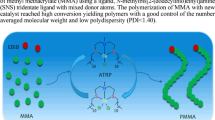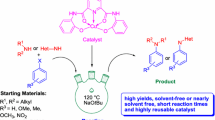Abstract
The ligands, 2,6-bis(NH-benzimidazol-2-yl)pyridine (L1) and 2,6-bis(N-methyl-benzimidazol-2-yl)pyridine (L2), were synthesized by a one-step reaction of 2,6-pyridinedicarboxylic acid with a diamine (o-phenylenediamine or N-methyl-1,2-phenylenediamine), respectively, in syrupy phosphoric acid at ca. 200 °C. Their efficiency as a catalyst in Cu-based atom transfer radical polymerizations (ATRP) of methylmethacrylate (MMA) was investigated. The linear first-order kinetic plots were observed; indicating that the number of active species is constant during the polymerization and termination reactions are limited. The apparent rate constant values of ATRP of MMA with CuCl/L1 catalyst system at 90 °C in acetonitrile were found to be between 3.83 × 10−5 and 1.33 × 10−4 s−1, while they were between 1.86 × 10−4 and 4.40 × 10−4 s−1 in the case of CuCl/L2 catalyst, indicating the presence of lower radical concentration throughout the polymerization of MMA using CuCl/L1 catalyst system. In both the cases, low apparent rate constant values are obtained. This indicates that ATRP proceeded at reasonable rates and a good control over ATRP in general. Apparent rate constant vs [ligand]/[catalyst] ratio plots showed a maximum at the [ligand]/[catalyst] ratio of two. M n,GPC values increased slightly linearly with conversion and molecular weight values were closer to M n,th in the case of ATRP of MMA using CuCl/L2 catalyst complex. Cyclic voltammetry measurements confirmed that CuCl/L1 and CuCl/L2 complexes in acetonitrile give reversible redox couples and copper(I) centers in CuCl/L1 and CuCl/L2 catalyst complexes that are readily oxidized and they potentially suit to facile ATRP.













Similar content being viewed by others
References
Braunecker WA, Matyjaszewski K (2007) Controlled/living radical polymerization: features, developments and perspectives. Prog Polym Sci 32:93–146
Wang W, Zhao J, Zhou N, Zhu J, Zhang W, Pan X, Zhang Z, Zhu X (2014) Reversible deactivation radical polymerization in the presence of zero-valent metals: from components to precise polymerization. Polym Chem 5:3533–3546
Matyjaszewski K, Tsarevsky NV (2014) Macromolecular engineering by atom transfer radical polymerization. J Am Chem Soc 136:6513–6533
Wang JS, Matyjaszewski K (1995) Controlled/”living” radical polymerization. Atom transfer radical polymerization in the presence of transition-metal complexes. J Am Chem Soc 117(20):5614
Kato M, Kamigaito M, Sawamoto M, Higashimura T (1995) Polymerization of methyl methacrylate with the carbon tetrachloride/dichlorotris- (triphenylphosphine) ruthenium(II)/methyl aluminum bis(2,6-di-tert-butylphenoxide) initiating system: possibility of living radical polymerization. Macromolecules 28(5):1721–1723
Percec V, Barboiu B (1995) “Living” radical polymerization of styrene initiated by arene-sulfonyl chlorides and CuI(bpy)nCl. Macromolecules 28(23):7970–7972
Arslan H (2012) Polymerization. In: De Souza Gomes A (ed) Block and graft copolymerization by controlled/“living” radical polymerization methods. ISBN 978-953-51-0745-3. INTECH, pp 279–320
Kamigaito M, Ando T, Sawamoto M (2001) Metal-catalyzed living radical polymerization. Chem Rev 101:3689–3746
Quchi M, Terashima T, Sawamoto M (2009) Transition metal-catalyzed living radical polymerization: toward perfection in catalysis and precision polymer synthesis. Chem Rev 109:4963–5050
Lena F, Matyjaszewski K (2010) Transition metal catalysts for controlled radical polymerization. Prog Polym Sci 35:959–1021
He W, Jiang H, Zhang L, Cheng Z, Zhu X (2013) Atom transfer radical polymerization of hydrophilic monomers and its applications. Polym Chem 4:2919–2938
Ran J, Wu L, Zhang Z, Xu T (2014) Atom transfer radical polymerization (ATRP): a versatile and forceful tool for functional membranes. Prog Polym Sci 39:124–144
Haddleton DM, Jackson SG, Bon SAF (2000) Copper(I)-mediated living radical polymerization under fluorous biphasic conditions. J Am Chem Soc 122:1542–1543
Sarbu T, Lin K, Spanswick J, Gil RR, Siegwart DJ, Matyjaszewski K (2004) Synthesis of hydroxy-telechelic poly(methyl acrylate) and polystyrene by atom transfer radical coupling. Macromolecules 37:9694
Cai Y, Hartenstein M, Müller AHE (2004) Synthesis of amphiphilic graft copolymers of n-butyl acrylate and acrylic acid by atom transfer radical copolymerization of macromonomers. Macromolecules 37:7484
Chung IS, Matyjaszewski K (2003) Synthesis of degradable poly(methyl methacrylate) via ATRP: atom transfer radical ring-opening copolymerization of 5-methylene-2-phenyl-1,3-dioxolan-4-one and methyl methacrylate. Macromolecules 36:2995
Coessens V, Pintauer T, Matyjaszewski K (2001) Functional polymers by atom transfer radical polymerization. Prog Polym Sci 26:337–377
Yuan X, Lu J, Xu Q, Wang L (2005) Atom transfer radical polymerization of styrene initiated by 2-(4-chloromethyl-phenyl)-benzoxazole with high activity and fluorescent property. Polymer 46:9186–9191
Muthukrishnan S, Jutz G, Andre X, Mori H, Müller AHE (2005) Synthesis of hyperbranched glycopolymers via self-condensing atom transfer radical copolymerization of a sugar-carrying acrylate. Macromolecules 38:9–18
Muthukrishnan S, Mori H, Müller AHE (2005) Synthesis and characterization of methacrylate-type hyperbranched glycopolymers via self-condensing atom transfer radical copolymerization. Macromolecules 38:3108–3119
Senkal BF, Hizal G, Bicak N (2001) Atom transfer radical polymerization through N-chlorosulfonamides. J Polym Sci Part A Polym Chem 39:2691–2695
Ydens I, Degee P, Dubois P, Libiszowski J, Duda A, Penczek S (2003) Combining ATRP of methacrylates and ROP of L, L-dilactide and ε-caprolactone. Macromol Chem Phys 204:171–179
Beers KL, Matyjaszewski K (2001) The atom transfer radical polymerization of lauryl-acrylate. J Macromol Sci Pure Appl Chem A38(7):731–739
Zhang Z, Ying S, Zhang Q, Xu X (2001) Well-controlled radical copolymerization of styrene with 2-[(perfluorononenyl)oxy] ethyl methacrylate and characterization of its copolymers. J Polym Sci Part A Polym Chem 39:2670–2676
Batt-Coutrot D, Haddleton DM, Jarvis AP, Kelly RL (2003) Synthesis and properties of amphiphilic vinyl acetate triblock copolymers prepared by copper mediated living radical polymerisation. Eur Polym J 39:2243–2252
Strissel C, Matyjaszewski K, Nuyken O (2003) Block copolymers from organomodified siloxane-containing macroinitiators by atom transfer radical polymerization. Macromol Chem Phys 204:1169–1177
Lee SB, Russell AJ, Matyjaszewski K (2003) ATRP synthesis of amphiphilic random, gradient, and block copolymers of 2-(dimethylamino)ethyl methacrylate and n-butyl methacrylate in aqueous media. Biomacromolecules 4:1386–1393
Cassebras M, Pascual S, Polton A, Tardi M, Vairon J (1999) Synthesis of di- and triblock copolymers of styrene and butyl acrylate by controlled atom transfer radical polymerization. Macromol Rapid Commun 20:261–264
Zhu S, Yan D (2000) Atom transfer radical polymerization of methyl methacrylate catalyzed by iron II chloride/ısophthalic acid system. Macromolecules 33:8233–8238
Zhang M, Breiner T, Mori H, Müller AHE (2003) Amphiphilic cylindrical brushes with poly(acrylic acid) core and poly(n-butyl acrylate) shell and narrow length distribution. Polymer 44:1449–1458
Arslan H, Yesilyurt N, Hazer B (2007) The synthesis of poly(3-hydroxybutyrate)-g-poly(methylmethacrylate) brush type graft copolymers by atom transfer radical polymerization method. J Appl Polym Sci 106:1742–1750
Zhang H, Klumperman B, Linde R (2002) Synthesis of anthracene end-capped poly(methyl methacrylate)s via atom transfer radical polymerization and its kinetic analyses. Macromolecules 35:2261
Zhang H, Van Der Linde R (2002) Atom transfer radical polymerization of n-butyl acrylate catalyzed by CuBr/N-(n-hexyl)-2-pyridylmethanimine. J Polym Sci Part A Polym Chem 40(21):3549–3561
Haddleton DM, Clark AJ, Crossman MC, Duncalf DJ, Heming AM, Morsley SR, Shooter A (1997) Atom transfer radical polymerisation (ATRP) of methyl methacrylate in the presence of radical inhibitors. Chem Commun, pp 1173–1174. doi:10.1039/A702166F
Raghunadh V, Baskaran D, Sivaram S (2004) Efficiency of ligands in atom transfer radical polymerization of lauryl methacrylate and block copolymerization with methyl methacrylate. Polymer 45:3149–3155
Davis KA, Matyjaszewski K (2000) Atom transfer radical polymerization of tert-butyl acrylate and preparation of block copolymers. Macromolecules 33:4039
Gurr PA, Mills MF, Qiao GG, Solomon DH (2005) Initiator efficiency in ATRP: the tosyl chloride/CuBr/PMDETA system. Polymer 46:2097–2104
Mühlebach A, Gaynor SG, Matyjaszewski K (1998) Synthesis of amphiphilic block copolymers by atom transfer radical polymerization (ATRP). Macromolecules 31:6046
Shen Y, Zhu S, Zeng F, Pelton R (2000) Atom transfer radical polymerization of methyl methacrylate by silica gel supported copper bromide/multidentate amine. Macromolecules 33:5427–5431
Wootthikanokkhan J, Peesan M, Phinyocheep P (2001) Atom transfer radical polymerizations of (meth)acrylic monomers and isoprene. Eur Polym J 37:2063–2071
Brar AS, Kaur S (2005) Tetramethylguanidino-tris(2-aminoethyl)amine: a novel ligand for copper-based atom transfer radical polymerization. J Polym Sci Part A Polym Chem 43:5906–5922
Teodorescu M, Matyjaszewski K (1999) Atom transfer radical polymerization of (meth)acrylamides. Macromolecules 32:4826–4831
Tsarevsky NV, Braunecker WA, Tang W, Brooks SJ, Matyjaszewski K, Weisman GR, Wong EH (2006) Copper-based ATRP catalysts of very high activity derived from dimethyl cross-bridged cyclam. J Mol Catal A Chem 257:132–140
Pintauer T, Matyjaszewski K (2005) Structural aspects of copper catalyzed atom transfer radical polymerization. Coord Chem Rev 249:1155–1184
Tsarevsky NV, Matyjaszewski K (2007) “Green” atom transfer radical polymerization: from process design to preparation of well-defined environmentally friendly polymeric materials. Chem Rev 107:2270–2299
Tang W, Matyjaszewski K (2006) Effect of ligand structure on activation rate constants in ATRP. Macromolecules 39:4953–4959
Dey S, Sarkar S, Paul H, Zangrando E, Chattopadhyay P (2010) Copper(II) complex with tridentate N donor ligand: synthesis, crystal structure, reactivity and DNA binding study. Polyhedron 29:1583–1587
Matthews CJ, Clegg W, Elsegood MRJ, Leese TA, Thorp D, Thornton P, Lockhart JC (1996) Synthesis and crystal structures of some bis-benzimidazoles, -benzothiazoles and -benzoxazoles by an alternative route: their complexation with copper(II) salts. J Chem Soc, Dalton Trans: 1531–1538. doi:10.1039/DT9960001531
Xu Z, Li T-K, Kim JS, LaVoie EJ, Breslauer KJ, Liu LF, Pilch DS (1998) DNA minor groove binding-directed poisoning of human DNA topoisomerase I by terbenzimidazoles. Biochemistry 37:3558–3566
Pilch DS, Liu H-Y, Li T-K, Kerrigan JE, LaVoie EJ, Barbieri CM (2003) Defining the molecular interactions that are important for the poisoning of human topoisomerase I by benzimidazoles and terbenzimidazoles. In: Demeunynck M, Bailly C, Wilson WD (eds) DNA and RNA binders: from small molecules to drugs, vol 2. Wiley-VCH, Weinheim, pp 576–608
Ruttimann S, Piguet C, Bernardielli G, Bocquet B, Williams AF (1992) Self-assembly of dinuclear helical and nonhelical complexes with copper(I). J Am Chem Soc 114:4230–4231
Piguet C, Borkovec M, Hamacek J, Zeckert K (2005) Strict self-assembly of polymetallic helicates: the concepts behind the semantics. Coord Chem Rev 249:705
Muller G, Maupin Christine L, Riehl James P, Birkedal H, Piguet C, Bünzli J-CG (2003) Structural, photophysical and chiro-optical properties of lanthanide complexes with a bis(benzimidazole)pyridine-based chiral ligand. Eur J Inorg Chem 2003:4065–4072
Zhang M, Zhang S, Hao P, Jie S, Sun W, Li P, Lu X (2007) Nickel complexes bearing 2-(benzimidazol-2-yl)-1,10-phenanthrolines: synthesis, characterization and their catalytic behavior toward ethylene oligomerization. Eur J Inorg Chem 2007:3816–3826
Liu S, Zuo W, Zhang S, Hao P, Wang D, Sun W (2008) Bis(2-(6-methylpyridin-2-yl)-benzimidazolyl)titanium dichloride and titanium bis(6-benzimidazolylpyridine- 2-carboxylimidate): synthesis, characterization, and their catalytic behaviors for ethylene polymerization. J Polym Sci Part A Polym Chem 46:3411–3423
Rodionov VO, Presolski SI, Gardinier S, Lim Y, Finn MG (2007) Benzimidazole and related ligands for cu-catalyzed azide-alkyne cycloaddition. J Am Chem Soc 129:12696–12704
Arslan H, Küçük Y, Mentes A, Acar MH (2013) A kinetic study of atom transfer radical polymerization of styrene with bis(2- pyridyl)ethylenedimethanimine derivative ligands. Turk J Chem 37:824–831
Arslan H, Kaptan MG, Zırtıl O, Hanhan ME, Şen Ş (2014) The synthesis of (N1E, N4E)-N1, N4-bis(pyridine-2-yl) ethylene)benzene-1,4-diamine and investigation of its efficiency as new binuclear catalyst complex in copper based ATRP. Polym Bull 71(5):1043–1059
Addison AW, Burke PJ (1981) Synthesis of some imidazole- and pyrazole-derived chelating agents. J Het Chem 18(4):803–805
Hijazi A, Walther ME, Besnard C, Wenger OS (2010) Spectroscopy and photoredox properties of soluble platinum(II) alkynyl complexes. Polyhedron 29(2):857–863
Şengül A, Kurt Ö, Adler PDF, Coles SJ (2014) Spectroscopic and structural properties of complexes of 3,3′-bis(2-benzimidazolyl)-2,2′-bipyridine with copper(I) and silver(I). J Coord Chem 67(14):2365–2376
Qiu J, Matyjaszewski K, Thouin L, Amatore C (2000) Cyclic polymerization. Macromol Chem Phys 201:1625–1631
Iovu M, Maithufi N, Mapolie S (2003) Copper-mediated ATRP of methyl methacrylate in polar solvents using a bifunctional pyridinal diimine ligand. Macromol Symp 193:209–226
Patten TE, Xia J, Abernathy T, Matyjaszewski K (1996) Polymers with very low polydispersites from atom transfer radical polymerization. Science 272:866–868
Acknowledgments
This work was supported by Bülent Ecevit University Research Fund, Turkey (BAP Project No: 2015-72118496-06 and BAP Project No: 2012-10-03-02).
Author information
Authors and Affiliations
Corresponding authors
Rights and permissions
About this article
Cite this article
Arslan, H., Avcı, Ç., Tutkun, B. et al. 2,6-Bis-benzimidazolylpyridines as new catalyst in copper-based ATRP. Polym. Bull. 74, 931–948 (2017). https://doi.org/10.1007/s00289-016-1754-8
Received:
Revised:
Accepted:
Published:
Issue Date:
DOI: https://doi.org/10.1007/s00289-016-1754-8




